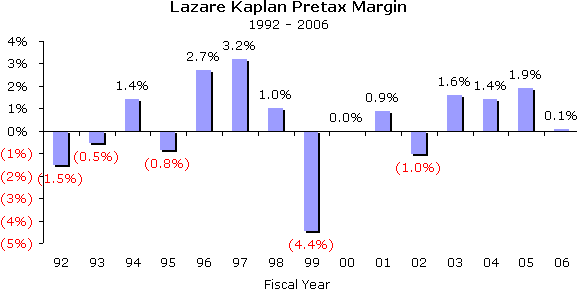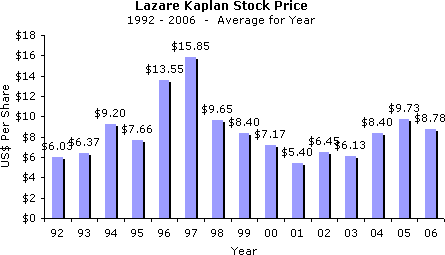IDEX Online Research: What’s Going On With Lazare Kaplan?
February 13, 07
Recently, Lazare Kaplan chairman Maurice Tempelsman and vice chairman Leon Tempelsman both agreed to take a 15 percent salary cut and forego a bonus this year. In addition, management announced that there would be no bonuses this year, and there would be changes in the way people are paid. Further, management implied that costs would be reviewed, and redundancies would be eliminated. People wondered: what’s going on at Lazare Kaplan? Are they in trouble?
The quick answer to these questions is this: Lazare Kaplan does not appear to be in imminent danger. Sales gains have been dramatic in the past few years. Cash flow appears to be reasonable, in view of its rapid growth. Its asset base and equity is growing. But its profit record has been disappointing.
Lazare Kaplan’s Profit Challenge: Contagious?
An analysis of the situation at Lazare Kaplan raises more questions than it answers, but it also raises one big question for diamantaires: are many diamond suppliers suffering from the same depressed margins and weak profits that characterize Lazare Kaplan? If so, perhaps it is time for the industry to reinvent its economic operating model.
Financial Performance Disappointing
While there are clearly many factors which affected management’s decision to take draconian measures to nurse the company out of its current profit malaise, it is also clear that something had to be done.
Between 1992, when we first began tracking Lazare Kaplan, and 2006, the company’s most recent fiscal year, revenues have increased by about 350 percent, from $152 million to $528 million. However, its has operated at around break-even for the entire period, without posting any significant profits, except for a couple of reasonably good years in the late 1990s.
Aggregate corporate revenues in the fifteen year period between 1992 and 2006 for Lazare Kaplan were $3.9 billion; its pretax profits were a mere $21 million, yielding a pretax margin of just 0.5 percent (one-half of one percent). In the entire fifteen year period, its pretax margin has never exceeded much more than 3 percent, a very modest return on sales. Arguably, anytime sales rise rapidly – as has happened over the past three years – profitability growth tends to lag. But profits haven’t caught up at Lazare Kaplan, and they don’t appear poised to catch up in the near term.
While shareholders’ equity has grown, its return on shareholders’ equity over the past five years has been weak at best, except for 2005 when the company posted a reasonable return on invested capital.
Sales Trends Strong Recently
The graph below summarizes Lazare Kaplan’s sales trends by year since 1992. As the graph illustrates, sales between 1994 and 2004 were fairly static in the $200-3000 million range. In the past two years, revenues have surged, due entirely to increased rough diamond trading activities, driven largely by the company’s activities in Angola.
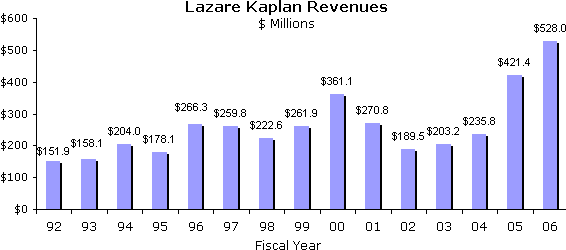 Source: Company Reports |
While revenues have risen, both over the short and longer term, profits have not shown any significant growth, other than a spike or two along the way.
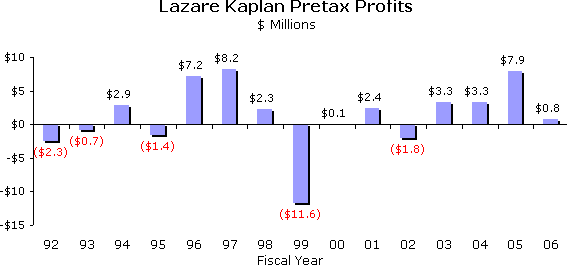 Source: Company Reports |
Pretax profit margins have remained relatively static since 1992, with a couple of exception years, both on the downside and the upside. The following graph summarizes historical pretax profit margins.
|
|
Best Use of Capital?
There are many ways to measure return on capital. We prefer to view financial returns based on investors’ capital – the equity of the company. The following graph illustrates the company’s return on invested capital. Assuming that an alternative return with a bank-issued Certificate of Deposit (CD) which is FDIC-insured could generate a return in the 4-5 percent range, it is clear that Lazare Kaplan’s return on shareholders’ equity beat the return on a CD in only one year out of the past eight.
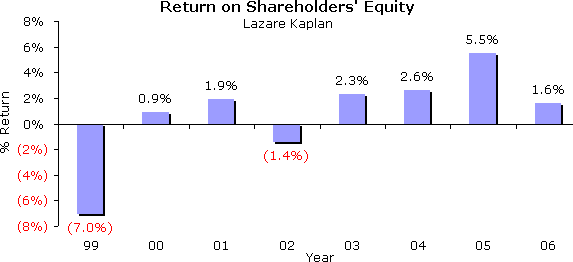 Source: Company Reports |
The company’s return on assets is even more disappointing, since its asset base is roughly three times the size of is equity base.
Some companies use debt to help leverage the return on shareholders’ equity. In recent years, Lazare Kaplan’s debt levels have risen commensurate with its sales growth, but even with the additional leverage of bank loans – which have a floating interest rate – the company has not been able to leverage its return to shareholders. During the fiscal year ended May 2006, its average interest rate for all outstanding borrowings was 5.8 percent; during that same fiscal year, the company provided a 1.6 percent return on shareholders’ equity. In other words, the banks have been the financial winners; shareholders have suffered with a sub-par return.
The graph below summarizes Lazare Kaplan’s long term debt levels versus its shareholders’ equity. Long term debt has been climbing, though not at an alarming rate, while shareholders’ equity has been relatively static.
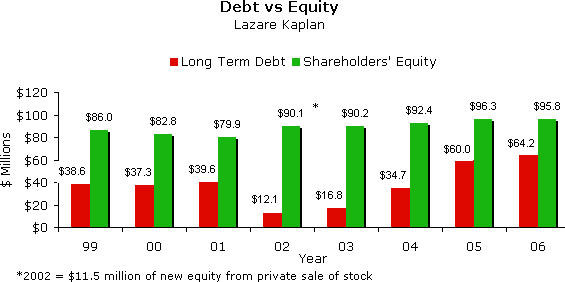
Source: Company Reports
Other Measures of Success
Because of our Wall Street background, we typically measure a company’s success based on financial returns. After all, financial investors are only interested in financial returns.
However, in today’s world, social concerns also have a role in measuring the success of a company. It could be argued that Lazare Kaplan has been a highly successful company by several other measures:
- It has created employment in needy African countries.
- It has helped bring stabilization to war-torn Angola.
- It has partnered with an African women’s empowerment group.
- It was a pioneer in diamond enhancement.
- It has been a leader in bringing technology to the diamond industry.
- It was a pioneer in diamond branding.
- Its chairman, Maurice Tempelsman, is a global ambassador for the diamond industry.
The problem is that none of these social issues count with the banks or Wall Street investors. While about 60 percent of its shares are held by the Tempelsman family – and another 5 percent is held by officers and directors – the company has an obligation to provide a reasonable return to its public shareholders. As a result of its disappointing profit performance as well as uneven sales and weak financial returns, the price of its stock has languished, as the following graph illustrates.
|
|
Other Challenges
Our analysis of Lazare Kaplan was restricted solely to its financial performance. Many factors could have brought on these disappointing results. For example, perhaps the company’s resources are stretched too far, since it has operations around the world. Perhaps management talent is lacking. Perhaps there is lack of focus by management. We did not attempt to address those questions.
The BIG Question
We reiterate: Lazare Kaplan appears financially stable, and appears to be in no imminent danger of financial distress near term. But the big question is this: are a number of other diamantaires struggling with the same financial pressures that are affecting Lazare Kaplan? If so, then it is time for those in the diamond supply chain to reinvent their economic operating model.
